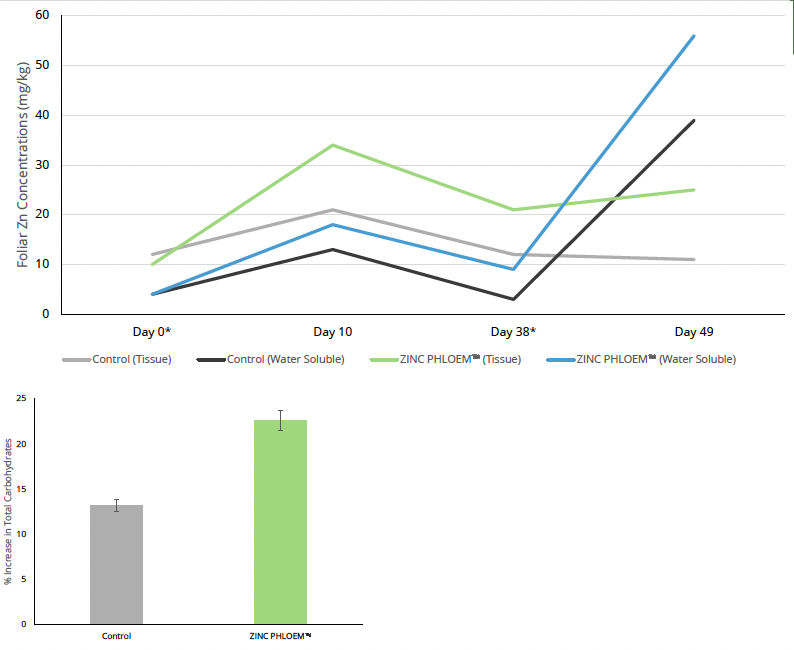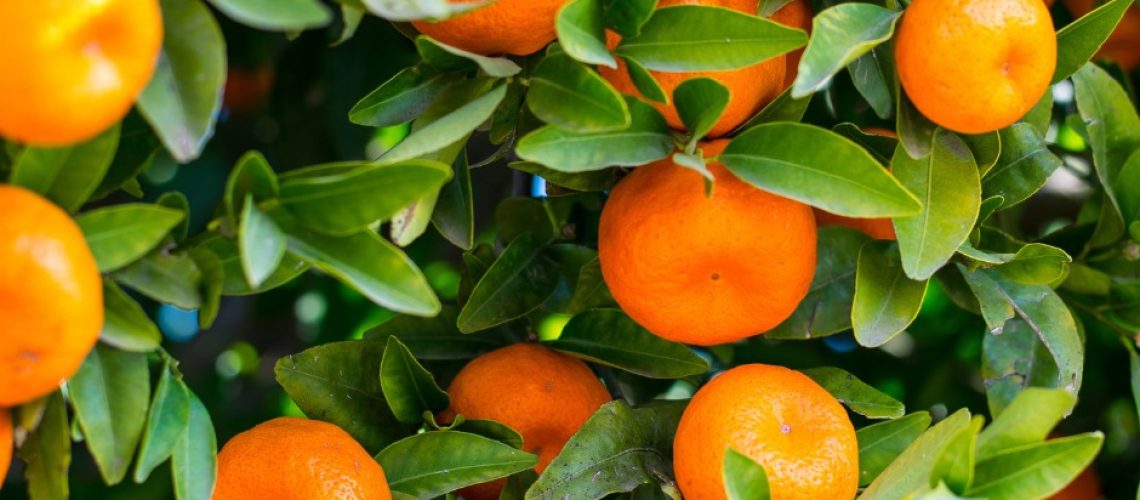ZINC PHLOEM™: Improving nutrient delivery and plant physiological status
By Rochelle Thuynsma, Head of Products: Technical
Role of zinc in plant physiology
Plant growth and development are dependent on a sufficient supply of zinc (Zn). Photosynthesis, the main metabolic pathway in plants, can be significantly reduced by Zn deficiency, which leads to a decrease in photosynthetic capacity, chlorophyll content and stability.(1)
This reduction results in lower carbohydrate production, negatively affecting plant growth, particularly during reproductive stages. Zinc is also crucial for plant hormone production, especially auxins, which stimulate root and stem elongation.(2) Additionally, Zn acts as an important co-factor in the respiratory chain, where carbohydrates are consumed to produce biomass.(3) The concentration of watersoluble Zn in leaves is closely correlated with chlorophyll levels. The positive influence of foliar Zn fertiliser on photosynthesis and chlorophyll synthesis can help increase the absorption and accumulation of mineral nutrients in functional mature leaves.(4)
Chemistry of Zn
Foliar application of Zn is an effective way to address Zn deficiency.(2) However, the source of Zn being applied is critically important. Zinc has a strong capability for fixation in the cell wall following foliar application of ZnSO4 and Zn (NO3)2, which limits Zn penetration and reduces the effectiveness of the application.(5) This is due to the ionic nature of ZnSO4 and Zn (NO3)2, which dissociate into cations (Zn2+) and anions (SO4 2-/NO3 -) in water.(6)
Zinc mainly exists in a bound form in the cytoplasm and other cellular compartments to avoid uncontrolled Zn2+ binding to non-target sites.(6) Various studies have shown that the abundance of negatively charged sites in the cell wall limits the translocation of positively charged Zn2+. For example, the major component of pectin in cell walls is polygalacturonic acid, which has a high binding capacity for Zn2+.(5) Generally, there is low potential for the remobilisation of foliar-absorbed nutrients until the binding sites within the leaf are saturated.(2)
Complexing agents in ZINC PHLOEM™
Complexing agents refer to the binding of a metal/ion to an organic molecule via weaker binding forces to one or several ionic groups on the compound.(7) In this instance, the metal/ ion is more available to dissociate from the binding.(8) The use of various natural complexes for foliar application of Zn enables rapid absorption and transfer of Zn through the stomata and epidermal pores of plant leaves.(9)
Organic acids are complexing agents that increase uptake efficiency and enhance plant assimilation.(7,9) These smaller molecules easily enter through the cuticle and stomata, have no net charge, and optimally diffuse through the leaf structure.(10) The organic nature of these compounds also ensures easy phloem loading and unloading, reducing the Adenosine triphosphate (ATP) cost for nutrient transport and assimilation, increasing nutrient use efficiency.(10,11) The resulting molecules, after nutrient cleavage, can feed directly into the plant metabolism, replenishing various metabolic intermediates, and serving as a source of carbon.(11)
Nutritional synergists in ZINC PHLOEM™
Various plant nutrients can affect the uptake and assimilation of other nutrients, ultimately influencing plant nutrient use efficiency.(12)
Nutrients can be classified as synergistic, antagonistic, or having no effect with reference to their interaction with other nutrients.(12) In formulating fertilisers, antagonistic nutrient interactions should be avoided, while synergistic nutrient interactions should be maximised for optimal nutrient use efficiency.(12)
ZINC PHLOEM™ is formulated with nutritional synergists to optimise nutrient delivery.
Nutritional synergists in ZINC PHLOEM™ can promote stomatal opening, providing more entry points for Zn to enter the leaf tissue. They can also act as a surfactant, reducing the surface tension of the foliar spray, and allowing the applied solution to spread more evenly and penetrate the leaf cuticle more effectively.
Efficacy of ZINC PHLOEM™
ZINC PHLOEM™ is an organically complexed, foliar-applied Zn formulation, formulated with nutritional synergists to enhance uptake and assimilation. Complexing organic acids in ZINC PHLOEM™ ensure efficient leaf uptake, as well as facilitating phloem loading and unloading. This increases the movement of nutrients from source to sink organs, as well as facilitating the assimilation of nutrients within sink tissues.
The efficacy of ZINC PHLOEM™ applications can be observed when compared to other market-related Zn-containing products. ZINC PHLOEM™ was effective in increasing foliar Zn levels to the same Zn level at half the applied concentration of the competitor product (Figure 1). ZINC PHLOEM™ is also readily taken up in waxy, thick cuticle leaves, such as those of macadamia trees (Figures 2A, 2B), where the application of ZINC PHLOEM™ increased both the leaf tissue concentration and water-soluble leaf Zn levels, after application on day 0 and day 38 (Figures 2A, 2B).

Figure 1: Foliar Zn tissue concentration (mg/kg) of various applied Zn sources, including an untreated control on butterhead lettuce.

Figures 2A and 2B: Foliar tissue and water-soluble Zn content (mg/kg) of macadamia trees after two applications of ZINC PHLOEM™ on day 0 (*) as well as 38 (*).

Figure 3: Foliar tissue Zn content (mg/kg) of avocado trees after two applications of ZINC PHLOEM™ on day (*) as well as 18 (*), when compared to ZnSO4 application.

Figure 4: Percentage increase (%) of foliar tissue Zn content of maize, soya and wheat plants treated with ZINC PHLOEM™ vs. ZnSO4.
In addition to these leaf samples, carbohydrate samples were also collected before and 10 days after application (Figures 2A, 2B).
Results show that the application of ZINC PHLOEM™ positively influenced the carbohydrate status of macadamia trees (Figures 2A, 2B). Carbohydrate status is a good indication of the ability of the tree to set and carry a number of flowers and fruit. A low carbohydrate status can lead to the early abscission of flowers and fruit/nuts as there are not enough reserves to sustain the high respiratory rate of these developing organs. Carbohydrate status can also indicate the efficacy of photosynthesis to produce sugars, which will later be used or stored as starch. Low carbohydrate status has been linked to alternate bearing cycles, where yields vary greatly between an on- and off-year.
Similarly, avocado trees treated with ZINC PHLOEM™ also showed increased leaf Zn levels when compared to trees treated with ZnSO4 (Figure 3).
ZINC PHLOEM™ is also effective on various crop groups and leaf shapes (Figure 4). ZINC PHLOEM™ increased foliar tissue Zn concentrations by 38% in maize, 10% in soya and 26% in wheat, when compared to standard ZnSO4 applications (Figure 4).
Conclusion
ZINC PHLOEM™ from Agri Technovation ensures effective zinc foliar nutrient uptake, movement and assimilation in various crop species with varying leaf physiologies.
ZINC PHLOEM™ is organically complexed and formulated with nutritional synergists to ensure efficient nutrient delivery and assimilation, overcoming the limitations usually associated with foliar applications.
Fertiliser group 2, Reg. no B5734, Act 36 of 1947, Zinc (ZN) 204 400 mg/L.
References:
- Xie, R., Zhao, J., Lu, L., et al. Penetration of foliar-applied Zn and its impact on apple plant nutrition status: in vivo evaluation by synchrotron-based X-ray fluorescence microscopy. Hortic Res 2020, 7, 147.
- Yumei, Li, P., Mulligan, D., Huang, L. Foliar zinc uptake process and critical factors influencing foliar Zn efficacy. Biointerface Res Appl Chem 2014, 4, 754-766.
- Marešová, J., Remenárová, L., Horník, M., et al. Foliar uptake of zinc by vascular plants: radiometric study. J Radioanal Nucl Chem 2012, 292, 1329-1337.
- Khan, M.R., Akram, M.S., Moonmoon, J.F., Tarafder, M.M.A., Rahman, M.H., Das, S., Hossain, A. Soil and foliar zinc application techniques influence the productivity, zinc concentration, and protein content in the grains of bread wheat varieties. Acta Agrobot 2023, 76, 1-13.
- Schreiber, L.; Schönherr, J. Penetration of ionic solutes. In Water and Solute Permeability of Plant Cuticles; Springer, 2009; pp. 125-144.
- Schreiber, L. Polar paths of diffusion across plant cuticles: New evidence for an old hypothesis. Ann Bot-London 2005, 95, 1069-1073.
- Schönherr, J. Characterization of aqueous pores in plant cuticles and permeation of ionic solutes. J Exp Bot 2006, 57, 2471-2491.
- Zhou, S., Chen, S., Yuan, Y., et al. Influence of Humic Acid Complexation with Metal Ions on Extracellular Electron Transfer Activity. Sci Rep 2015, 5, 17067.
- Li, T., Song, F., Zhang, J., Tian, S., Huang, N., Xing, B. Experimental and modelling study of proton and cop per binding properties onto fulvic acid fractions using spectroscopic techniques combined with two-dimensional correlation analysis. Environ Pollut 2020, 256, 113465.1-113465.16.
- Boguta, P., Sokołowska, Z. Zinc Binding to Fulvic acids: Assessing the Impact of pH, Metal Concentrations and Chemical Properties of Fulvic Acids on the Mechanism and Stability of Formed Soluble Complexes. Molecules 2020, 25(6), 1297.
- Nikoogoftar-Sedghi, M., Rabiei, V., Razavi, F., et al. Fulvic acid foliar application: a novel approach enhancing antioxidant capacity and nutritional quality of pistachio (Pistacia vera L.). BMC Plant Biol 2024, 24, 241.
12 . Rietra, R. P. J. J., Heinen, M., Dimkpa, C. O., & Bindraban, P. S. (2017). Effects of Nutrient Antagonism and Synergism on Yield and Fertilizer Use Efficiency. Communications in Soil Science and Plant Analysis, 48(16), 1895–1920.





